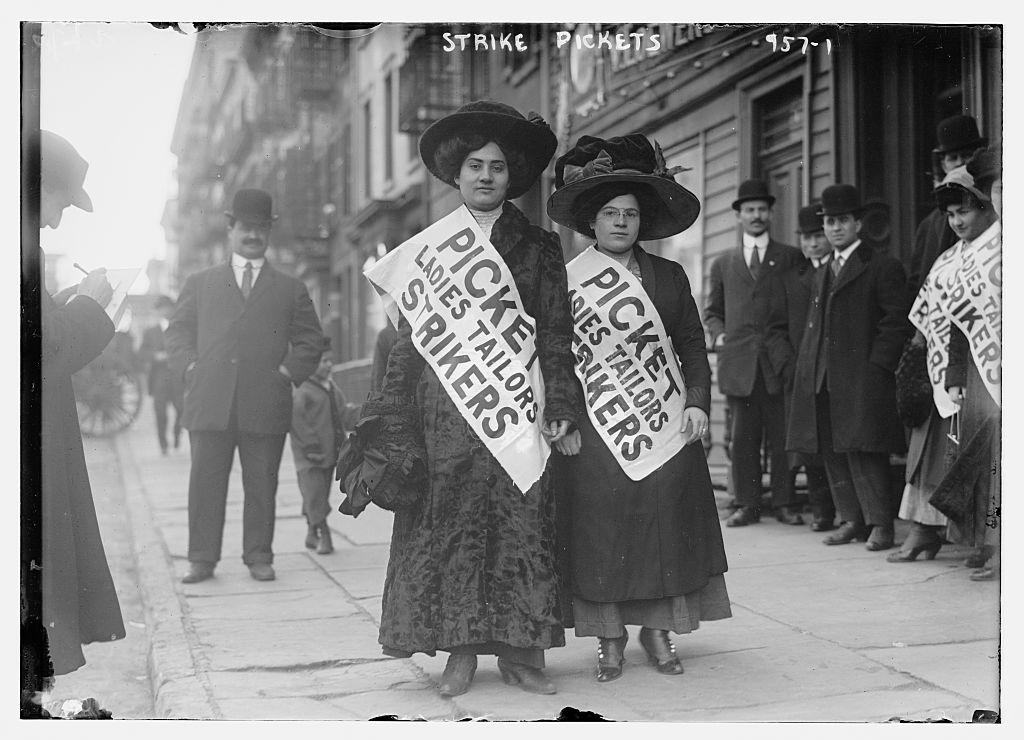Why learn about the Progressive Era?

Figure 1. The Progressive Era is characterized by petitions for social and economic change. This image shows strikers involved with the New York shirtwaist strike of 1909, in which more than 20,000 garment workers, most between the ages of sixteen and twenty-five, protested their long hours and low wages, demanding a pay raise, better hours, and safer working conditions.
Imagine this: It’s a Wednesday afternoon. You just finished your last class of the day and are heading off to your retail job, where you get paid $10 an hour to stock shelves and assist customers. During today’s shift, you had some safety modules to study, which focused on preventing injuries and using appropriate materials. After work, you head home and cook up some hot dogs for a late-night dinner.
This may seem like a normal Wednesday evening, but ask yourself these questions:
- Why is your employer paying you $10 an hour instead of $3? Why is your employer concerned about workplace safety?
- Do you really know what’s in your hot dog? How do you know it’s safe to eat?
These are questions you probably don’t often think about, but enforceable standards regarding the minimum wage, workplace safety, and foods that are safe to are a result of government intervention in the years during and following the Progressive Era.
Simply stated, the reforms and movements of the Progressive Era directly affect your life in the present day. “Never in the history of the world was society in so terrific flux as it is right now,” Jack London wrote in The Iron Heel, his 1908 dystopian novel in which a corporate oligarchy comes to rule the United States. He continued, “The swift changes in our industrial system are causing equally swift changes in our religious, political, and social structures. An unseen and fearful revolution is taking place in the fiber and structure of society. One can only dimly feel these things, but they are in the air, now, today.”
The many problems associated with the Gilded Age—the rise of unprecedented fortunes and unprecedented poverty, controversies over imperialism, urban squalor, an escalating conflict between capital and labor, loosening social mores, unsanitary food production, the onrush of foreign immigration, environmental degradation, and the emergence of political radicalism—confronted Americans. Terrible forces seemed out of control and the nation seemed imperiled. Farmers and workers had been waging political war against capitalists and conservatives for decades, but then, slowly, toward the end of the nineteenth century, a new generation of middle-class Americans intervened themselves in public life and advocated new reforms to tame the many excesses, inequalities, and perils of the Gilded Age.
Widespread dissatisfaction with new trends in American society spurred the Progressive Era, named for the various efforts toward reform and problem solving that attracted a range of constituencies and activists. While Americans had different ideas about how the country’s development should be managed and whose interests required the greatest protection, the main goal was to clean up politics. Black Americans continued their long struggle for civil rights; women demanded the vote as well as greater equality in society at large; and workers demanded higher wages, safer workplaces, and the union recognition that would guarantee these rights. Whatever their specific motivations, reform became the word of the age, and the sum of these efforts gave the era its name.
Candela Citations
- Modification, adaptation, and original content. Authored by: CJ McClung for Lumen Learning. Provided by: Lumen Learning. License: CC BY-SA: Attribution-ShareAlike
- US History. Provided by: OpenStax. Located at: http://openstaxcollege.org/textbooks/us-history. License: CC BY: Attribution. License Terms: Access for free at https://openstax.org/books/us-history/pages/1-introduction
- The Progressive Era. Provided by: The American Yawp. Located at: https://www.americanyawp.com/text/20-the-progressive-era/. License: CC BY: Attribution
- Strike Pickets. Provided by: Library of Congress. Located at: https://www.loc.gov/item/2014684501/. License: Public Domain: No Known Copyright